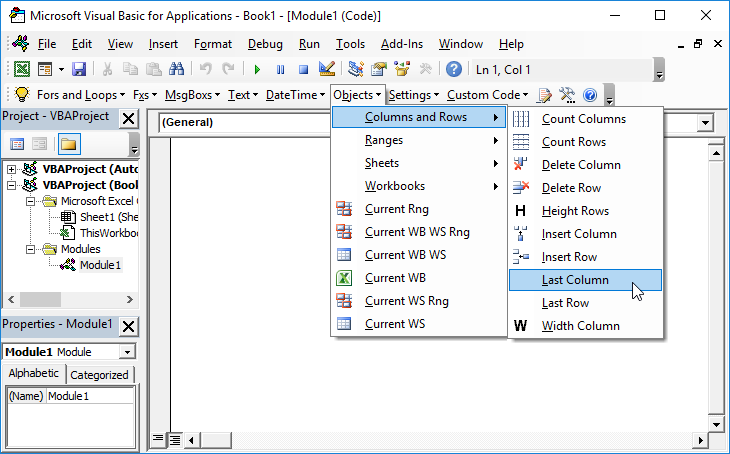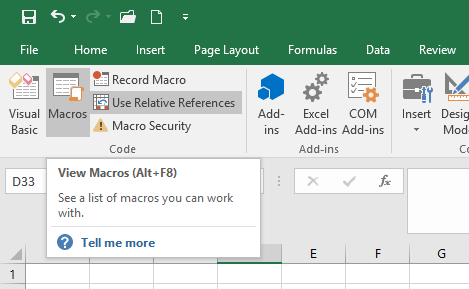

Learn how to declare and initialize an excel vba variable of type Integer, String, Double, Boolean and Date.Ģ String Manipulation: There are many functions in Excel VBA we can use to manipulate strings. Excel VBA Programming is not difficult, but you do need to know the keywords used in Excel VBA.ġ Variables: Excel VBA uses variables just like any other programming language. This section is for users who want to get the most out of Excel VBA. The application object gives access to a lot of Excel related options.
#EXCEL VBA TUTORIAL FOR BEGINNERS CODE#
They are very useful when your macro code has to be executed on different workbooks or worksheets.ĩ Application Object: The mother of all objects is Excel itself. The Workbook and Worksheet object are commonly used in Excel VBA. You will see that the Worksheet and Workbook object have properties and methods as well, such as the count property which counts the number of active workbooks or worksheets. Learn more about the object hierarchy of Excel Visual Basic.Ĩ Workbook and Worksheet: In this chapter you will learn more about the Excel VBA Workbook and Excel VBA Worksheet object. Excel Visual Basic is a semi-object oriented programming language.

This way most of the errors can be corrected before you execute your code.ħ Objects, Properties and Methods: In this chapter you will learn more about Excel VBA objects. This chapter provides you with a simple tip to deal with these errors.Ħ Debug Macros: Before you execute your VBA-code you can first debug your macro.

The Visual Basic Editor is the starting point for creating macros in Excel VBA, so it is important to get this configuration right.ģ Macro Comments: Add macro comments to your Excel VBA code and your code will be easier to read as program size increases.Ĥ MsgBox: The Message Box is a dialog box you can have appear to inform the users of your program.ĥ Macro Errors: Dealing with VBA-errors can be quite a challenge. Make sure your macro security settings are set up correctly so no harm can be done to your computer.Ģ Visual Basic Editor: Learn how to launch the Visual Basic Editor and get the best configuration of the Project Explorer and the Code Window in your Excel Version.

It is good to know the basic terminology explained in this section before you start programming in Excel Visual Basic.ġ Macro Security: Setting up your macro security settings correctly is essential to protect yourself against potential viruses. This section explains the basics of Excel Visual Basic. This chapter explains the ins and outs of the Excel Macro Recorder. Next, you can execute the task over and over with the click of a button which can save you a lot of time. With the Excel Macro Recorder you can record a task you perform with Excel. Next, you can create aĬommand button and assign a macro to the command button.Ģ Excel Macro Recorder: The Excel Macro Recorder is a very useful tool included in Excel VBA. Excel VBA allows you to do these things in Excel.ġ Create a Macro: To create a macro in Excel VBA, first activate Excel Visual Basic. This can save you a lot of time! More importantly there are certain things you cannot do with Excel alone. With Excel VBA you can automate a task in Excel by writing a so called Macro. This section is for Excel users with no knowledge of Excel VBA.Įxcel VBA, which stands for Excel Visual Basic for Applications, is the name of the programming language of Microsoft Excel. Invest in yourself by ordering our example programs and learn Excel VBA quickly Good example programs say more than a lengthy description of the theory. There is really only one way to master Excel VBA, and that is by doing it. Jesse - Newport Beach, United States - "You have the simplest, most comprehensible material I have found for a VBA beginner." It doesn't matter if you are new to Excel VBA and want to start from scratch or just want to use this tutorial as a reference. Our easy to follow tutorial (Macro?, Basics, Programming and Controls) teaches you how to create all sorts of macros in Excel VBA.


 0 kommentar(er)
0 kommentar(er)
